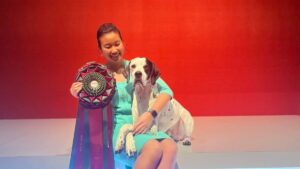
2023 Top Junior Handler Lila Holberg
Explore the journey of Lila Holberg, 2023’s top Junior Handler, who triumphed over 1,881 peers, achieving significant accolades.

Home » Dog Breeds » Wirehaired Pointing Griffon Dog Breed
The Wirehaired Pointing Griffon is a distinguished and versatile gundog known for its tenacity and its keen nose. Originating in the Netherlands and developed in Germany, this breed exhibits a unique combination of robustness and agility paired with a wiry coat that provides protection in dense cover. The “Griffon” is not only a reliable hunting partner, however. Although it is ideally suited for the field, it is also a devoted family member, thriving on human companionship and exhibiting a friendly and intelligent demeanor to everyone it meets.
Sporting
20 – 24 Inches
35 – 70 Pounds
12 – 15 Years
| Country of Origin | Germany and The Netherlands |
|---|---|
| Bred For | Upland Game Bird and Waterfowl Hunting, Companionship |
| Known For | Catlike Gracefulness, Supreme Gundog, Unkempt Appearance |
| Popularity | Moderate |
| Temperament | Outgoing, Trainable, Trustworthy |
| Activities | Hunting, Running, Swimming, Hiking, Conformation Shows, Dog Sports |
The Wirehaired Pointing Griffon is a unique breed with a rich history that traces back to 19th century Europe. The “Griffon” was developed by a Dutch breeder named Eduard Karel Korthals, who was passionate about creating the ultimate gun dog. Korthals’s quest began while he was managing the kennels of the Duke of Plessis in Germany, where he carefully selected and bred various types of gundogs with an emphasis on traits such as robustness, intelligence, and a keen sense of smell. His aim was to produce a dog that could handle the varied and difficult terrain that local hunters encountered most often.
Korthals’s dedication to his breeding program was intense and thorough, with records providing meticulous documentation and a clear vision for the breed’s characteristics. He desired a dog that was as skilled in pointing as it was in retrieving, capable of working on all kinds of environments and in all weather conditions. His efforts resulted in a breed known for its wiry coat that protected it from harsh underbrush and inclement weather, and for its remarkable skill in pointing and retrieving game.
The Griffon quickly gained popularity in Europe for its hunting prowess and spread to other countries, including the United States. Many American hunters quickly valued the breed for its versatility, trainability, and reliable performance in the field. Throughout the 19th century, its popularity continued to grow and it was officially recognized by the American Kennel Club (AKC) in 1887.
In addition to the AKC, the breed has also been recognized by other major canine organizations, such as the Fédération Cynologique Internationale (FCI), which is essentially the World Canine Organization, and The Royal Kennel Club (UK), both of which have contributed to maintaining a Breed Standard and promoting the breed’s capabilities in Great Britain and around the world.
For well over a century, the Wirehaired Pointing Griffon has been appreciated not only for its abilities in the field but also for its amiable nature as a faithful companion. This dual-purpose has made the breed a cherished choice for both hunters and families alike, ensuring its place among many generations of dog enthusiasts. Over the years, the breed has maintained its reputation as a dedicated hunter with a keen nose and hard-working spirit, attributes that were so carefully instilled by its founder. Today, the Griffon continues to be a testament to its creator’s vision of a versatile and steadfast hunting companion.
Adult male Wirehaired Pointing Griffons typically stand between 22 and 24 inches tall at the shoulder, while mature females are slightly smaller, ranging from 20 to 22 inches in height.
Weight should be proportionate to the height, with males averaging around 50 to 70 pounds and females weighing in at approximately 35 to 50 pounds.
The Wirehaired Pointing Griffon exhibits a body that is slightly longer than it is tall, adhering to a ratio of 10 to 9. Despite the breed’s medium size, the Griffon possesses a substantial build, robust yet never cumbersome. This form facilitates both the power and agility necessary for rigorous fieldwork. Musculature is well-developed in the breed, providing these dogs with the strength and endurance that are hallmarks of its hunting heritage.
Texture: The coat of the Wirehaired Pointing Griffon consists of a soft, insulating undercoat and a hard, wiry outer coat. Texture can vary, but the head will always be furnished with a prominent mustache and eyebrows, which are an extension of the undercoat. The legs are covered in hair that is shorter and denser, with a texture that is less coarse than that on the body coat. The hair on the ears is short and soft, with a mixture of longer, harsher hairs. The coat is not clipped, stripped or trimmed except for the hair on the top of the head, ears, cheeks, and feet. In general, the breed’s protective coat equips the Griffon well for work without hindrance in challenging outdoor environments.
| Standard Color | |
|---|---|
| Brown & Gray | ee |
| Chestnut & Gray | ee |
| White & Brown | ee |
| White & Orange | ee |
| White | ee |
| Brown | ee |
| Chestnut | ee |
A Note About Color: The color of the Griffon’s coat is ideally steel gray with brown markings or roan, white, and brown. A solid brown coat, all-white coat, or white and orange coat are less desirable, and a black coat is unacceptable.
| Standard Marking | |
|---|---|
| Ticked | ee |
| Roan | ee |
The tail of the Wirehaired Pointing Griffon is an extension of the dog’s topline. It is carried straight or is slightly raised, and it moves in a manner that expresses the dog’s keen interest and activity level, especially when in motion or while working in the field.
Traditionally, the tail is docked to approximately 40 to 60 percent of its full length. This practice is rooted in the breed’s hunting heritage, where a shorter tail is thought to prevent injuries in the rough underbrush. In countries where docking is prohibited, the tail is left in its natural state.
Whether docked or natural, the tail’s appearance is enhanced by the wiry coat, which provides protection and adds to the overall unkempt look of the breed. The tail does not have excessive feathering, keeping with the practical and unadorned aesthetic that is a hallmark of the breed’s functional design.
Embarking on the journey of owning a Wirehaired Pointing Griffon requires a thoughtful understanding of the breed’s unique attributes and requirements for its care. These dogs are known for their versatile hunting skills, intelligence, and affectionate nature, which makes them both a delightful companion and a dedicated sportsman’s partner. Prospective owners should be prepared for a dog that is active and requires meaningful engagement—both mentally and physically.
Committing to a Griffon means making sure the dog has ample opportunities to exercise its body and mind, reflecting the dog’s heritage as a tireless field worker. This breed thrives with human companionship and may not be well-suited for those who cannot provide it with a substantial amount of time and attention.
The Wirehaired Pointing Griffon is generally a hearty and resilient breed, possessing the robust health needed for a vigorous life outdoors. Nonetheless, conscientious caretakers should be aware that the breed may be predisposed to certain health conditions. To maintain its well-being, it is important to schedule regular veterinary check-ups, which allow for early detection and management of any health issues that may arise.
Lifespan: In terms of longevity, Wirehaired Pointing Griffons typically enjoy a lifespan of 12 to 15 years.
Achieving this lifespan is often a result of comprehensive care, which includes a balanced diet, routine health screenings, and proactive disease prevention. With a dedication to the dog’s health and happiness, a Griffon can be a long-lived companion, providing years of enjoyment and many shared experiences.
The Wirehaired Pointing Griffon, though robust and sturdy, does have health concerns that potential and current owners should be aware of:
Caretakers of Wirehaired Pointing Griffons should engage in a proactive partnership with their dog’s breeder and a veterinarian who is familiar with the breed. Routine veterinary visits for vaccinations, dental care, and parasite control, along with the recommended health screenings, are instrumental in preventing and managing any health risk. This proactive approach helps with the well-being of the Griffon, allowing it to lead a full and active life.
The personality of the Wirehaired Pointing Griffon is one of keen alertness, vivacity, and a gentleness, making these dogs an excellent companion both in the field and at home. Their amiable nature often means they are good with children and can integrate well into a family setting. However, due to their high intelligence and active mind, they are not always the best match for novice owners. They thrive with an experienced handler who can provide firm, consistent training and who understands the needs of working breed dogs.
These dogs typically do well when left alone for moderate periods, provided they have been given enough exercise and mental stimulation. Nevertheless, they are a breed that prefers company and may become unhappy if isolated for too long. Their sociability usually extends to other dogs as well, and with proper socialization they are often eager to play and interact with their canine companions.
Regarding strangers, the Wirehaired Pointing Griffon can be cautious initially, but they are generally not aggressive without provocation. They are known to be quite perceptive and can become welcoming once they ascertain there is no threat, often warming up quickly to new people under the guidance of their trusted human partner. It is this blend of intelligence, friendliness, and loyalty that makes the Griffon a versatile and endearing breed to those who are familiar with its characteristics and needs.
Feeding a Wirehaired Pointing Griffon appropriately is essential to maintain their health and energy levels. As puppies, they require a diet formulated for active breeds with a growth pattern that supports their energetic nature. It is often recommended to feed them high-quality puppy food divided into three to four meals a day to support their rapid growth phase.
As adults, the breed’s diet should be adjusted to match their activity level. A high-quality commercial dog food or a well-balanced homemade diet, under veterinary guidance, should suffice. The amount of food, typically measured in cups, can vary depending on the dog’s size, age, and activity level. On average, an adult Wirehaired Pointing Griffon may require between 2 to 3 cups of dry dog food per day, ideally divided into two meals to prevent bloating and promote digestive health.
Regular feeding schedules and avoiding excessive treats are key to preventing obesity, especially as the breed may slow down with age. Fresh water should be available at all times, and dietary needs may change as the dog ages or if there are health concerns, so it is important to regularly discuss nutrition with a veterinarian. An optimally fed Wirehaired Pointing Griffon is usually a healthy and happy companion, ready for whatever activities the day may bring.
Training a Wirehaired Pointing Griffon requires patience and consistency, given their independent nature and high intelligence. They respond best to positive reinforcement techniques, such as treats and praise, rather than harsh corrections. This breed possesses a natural instinct for hunting and pointing, so their training should start early, especially to hone these skills for those who wish to use them in the field.
While they are intelligent and capable of learning a wide variety of commands and tasks, Griffons can exhibit a stubborn streak. Early socialization and puppy training classes are recommended to help them develop into well-adjusted adults. They have a moderate tendency to bark, which can be managed with proper training and socialization.
Their intelligence means they can be easy to train in the right hands, but it also means they can get bored easily. Therefore, training sessions should be kept engaging and varied to hold their attention. Despite their hunting background, Wirehaired Pointing Griffon’s predation instinct is generally not as high as some other breeds, but they will chase wildlife if given the opportunity, so a reliable recall is essential.
Given their working breed heritage, Griffons also have a moderate wanderlust potential. Training should include a strong emphasis on recall and boundaries to ensure they do not stray too far during outdoor adventures. With the right approach, a Wirehaired Pointing Griffon can be a joy to train and will develop into a loyal and obedient companion.
The exercise needs of the Wirehaired Pointing Griffon are substantial, aligning with their origins as a vigorous hunting dog. These dogs have a high energy level that requires regular, structured activities to keep them physically fit and mentally stimulated. They are not a breed that will be content with a sedentary lifestyle or with being left alone for long periods without the opportunity to engage in robust exercise.
| Energy Level | Moderate to High |
|---|---|
| Exercise Requirements | 1 Hour/Day (Minimum), Daily Walks, Vigorous Running, Weekly Swimming, Playing with Another Dog, Mental Stimulation |
Their intensity is palpable, especially when they are given tasks that simulate their natural working behaviors, such as retrieving or scent work. Owners should be ready to provide them with daily exercise that goes beyond a leisurely walk. Hiking, running, and playing fetch are great ways to channel their energy productively.
Playfulness is another trait that can be used to an owner’s advantage during exercise. Interactive games that challenge them both mentally and physically can be particularly beneficial and enjoyable for the Griffon. Owners can consider activities that allow these dogs to exercise their instincts, such as tracking, agility, or even advanced obedience training.
Given their high energy and need for vigorous exercise, Wirehaired Pointing Griffons are not ideally suited to apartment living unless their exercise needs can be met through other means. They are best suited to homes with more space where they can run and play freely. Regular, dedicated exercise sessions will help ensure that the Griffon remains a well-balanced and content companion.
The grooming requirements for a Wirehaired Pointing Griffon are moderate and essential for the dog’s well-being. The distinctive wiry coat of the Griffon is not only an aesthetic feature but also serves as protection in rough terrain and inclement weather. Regular grooming helps to maintain the coat’s functional qualities and keeps the dog comfortable.
| Coat Type | Harsh, Coarse |
|---|---|
| Grooming Requirements | Weekly Brushing, Occasional Bathing, Routine Ear Cleaning, Periodic Nail Trimming, Regular Tooth Brushing |
Brushing a couple of times a week is generally sufficient to remove dead hair and prevent matting. The coat does not shed excessively, but it does shed, and routine brushing will help to manage loose hair and maintain the coat’s condition.
In addition to brushing, the coat may require hand-stripping or clipping to remove dead hair and encourage new growth, particularly for those dogs that are shown or that have longer coats. Hand-stripping is a technique used to pull out the dead outer coat, and it is generally done a few times a year, depending on the dog’s coat growth cycle.
It’s also important to attend to other grooming tasks such as cleaning the ears to prevent infections, trimming the nails to avoid overgrowth and splitting, and dental care to ensure good oral health. Regular grooming sessions are not only a necessity for the breed’s coat and health but also provide an opportunity to strengthen the bond between the dog and their human companion. With consistent grooming, this breed can remain a handsome and happy participant in all of life’s adventures.
Living with a Wirehaired Pointing Griffon is a rewarding experience for an active individual or family who understands the breed’s specific needs. Their adaptable nature means that while they can adjust to apartment living, they thrive in environments where they have more space to express their energy, such as a home with a securely fenced yard.
Despite their thick, wiry coat, the Griffon is well-suited to a variety of climates. Their coat provides ample warmth, making them quite comfortable in cooler temperatures. However, it is important to monitor them and provide protection in extreme cold to prevent any risk of frostbite to sensitive areas like the ears and paws. Conversely, in hot weather, their coat can protect them from the sun, but they should always have access to shade and fresh water, and their exercise should be scheduled during the cooler parts of the day to prevent overheating.
Griffons typically do well in households with children and other dogs, given their sociable nature. They are generally friendly towards strangers as well, though they may exhibit initial caution as part of their alert temperament. Making sure that they have been properly socialized will help foster their innate friendliness and ensure that their caution does not turn into shyness or fearfulness.
Those considering adding a Griffon to their life should be prepared to integrate this active dog into many of their daily activities. The Griffon is happiest when they can be part of the family’s routine, whether that’s being involved in outdoor adventures or simply hanging out at home with their human companions. For those willing to invest time in exercise, training, and companionship, the Wirehaired Pointing Griffon can be an exceptional partner.
The arrival of a litter of Wirehaired Pointing Griffon puppies is an exciting experience and the beginning of a wonderful journey. These pups are inquisitive, energetic, and eager to explore their environment. New caretakers should be prepared for the task of channeling their boundless energy and curiosity in positive directions. From the moment a Griffon puppy steps paw into its new home, the foundation for future temperament and behaviors is being laid.
Caring for a Wirehaired Pointing Griffon puppy involves more than just meeting its physical needs; it also includes training and socialization at an early stage. Nutrition plays a crucial role in the pup’s development, and feeding a balanced diet designed for puppies will support its growth and health. Puppy food should be rich in nutrients that support a puppy’s high energy levels and rapid growth.
Puppies do not regulate their food intake as adults do, so it is essential to establish a feeding routine. Breaking down the puppy’s daily food requirement into several smaller meals can help to prevent overeating and maintain a healthy digestion. As the pup grows, the number of meals can decrease as the portion size increases, until the growing pup transitions to an adult feeding schedule.
Socialization is just as important as nutrition and involves exposing the puppy to a variety of people, places, and situations. This exposure helps the Griffon pup to grow up into a well-adjusted and confident adult dog. Introducing a puppy to different environments, both indoors and outdoors, and a range of friendly humans and animals can aid in this process.
Basic obedience training should start early with simple commands like sit, stay, and come. This not only helps with the puppy’s behavior but also strengthens the bond between the puppy and its caretaker. Potty training is another crucial part of early care, requiring consistency, patience, and positive reinforcement.
Healthcare, such as vaccinations, worming, and flea prevention, should be carried out under the guidance of a veterinarian to protect the puppy’s overall health. The pup will also benefit from gentle grooming practices that are introduced early. These sessions allow the Griffon pup to accept and even enjoy the grooming process as part of its regular routine.
The Wirehaired Pointing Griffon is an energetic and versatile breed that excels in a variety of canine activities. The breed’s keen intelligence and eager disposition make these supremely gifted dogs suitable for many competitive events that can help to keep them physically fit and mentally sharp. Here are some of the dog sports in which the Griffon can participate:
These activities provide excellent opportunities for Wirehaired Pointing Griffons to harness their energy and for their handlers to engage in a rewarding partnership with their canine companions. Participation in these sports not only provides physical and mental stimulation for the dog, it also reinforces the bond between the Griffon and its human partner.
The Wirehaired Pointing Griffon is recognized by the world’s leading registries and kennel organizations, which categorize the breed into a specific Group based on its unique characteristics. This breed is recognized worldwide under the following Group designations:
| Organization | Group Designation |
|---|---|
| AKC (American Kennel Club) | Sporting |
| UKC (United Kennel Club) | Gun Dog |
| CKC (Canadian Kennel Club) | Sporting Dogs |
| ANKC (Australian National Kennel Council) | Not Recognized |
| RKC (The Royal Kennel Club) | Gundog |
| FCI (Fédération Cynologique Internationale) | Group 7 – Pointing Dogs; Section 1.3. – Continental Pointing Dogs, “Griffon” Type |
The ideal Wirehaired Pointing Griffon is described by a Breed Standard that is approved by each of the world’s leading registries and kennel organizations. The Breed Standards for this breed may be found in the following links:
| Organization | Breed Standard |
|---|---|
| American Kennel Club | AKC Wirehaired Pointing Griffon Breed Standard |
| United Kennel Club | UKC Wirehaired Pointing Griffon Breed Standard |
| Canadian Kennel Club | CKC Wirehaired Pointing Griffon Breed Standard |
| Australian National Kennel Council | Not Recognized |
| The Royal Kennel Club | RKC Wirehaired Pointing GriffonBreed Standard |
| Fédération Cynologique Internationale | FCI Wirehaired Pointing Griffon Breed Standard |
Wirehaired Pointing Griffon clubs play a pivotal role in the preservation and promotion of the breed. These organizations are not only a resource for breed enthusiasts and breeders, they also serve as guardians of the Breed Standard, promoters of canine health research, and organizers of events that showcase the breed’s many abilities.
In the United States, the American Wirehaired Pointing Griffon Association (AWPGA) is a national club dedicated to the interests of the breed. The AWPGA is recognized by the American Kennel Club as the official parent club for the Wirehaired Pointing Griffon. It provides its members with information on breed health, training, and upcoming conformation shows, performance events, and field activities.
Canada also has a national breed club known as the Wirehaired Pointing Griffon Club of Canada, which fosters the same dedication to the breed, overseeing the Breed Standard and supporting members from coast to coast.
Wirehaired Pointing Griffon clubs are more than just social groups; they are the backbone of the breed in their respective countries, promoting responsible ownership and breeding practices, advocating for the breed, and making sure that this supreme gun dog continues to thrive and perform the roles for which it was originally bred.
Rescue groups play a crucial role in the welfare of dogs today, occasionally needing to step in to provide care for abandoned, lost, or surrendered Wirehaired Pointing Griffons, making sure that they find their way to safe, loving permanent homes.
In the United States, the Wirehaired Pointing Griffon rescue network is fostered by the breed’s national club, the American Wirehaired Pointing Griffon Association (AWPGA). This volunteer organization is committed to the rescue and rehoming of Griffons, and its members work closely with volunteers and shelters to protect the welfare of any Griffon in need.
In instances where breed-specific rescue organizations are not available, local all-breed shelters and rescue groups might occasionally have a Wirehaired Pointing Griffon in need of a new home. Potential adopters can check with local shelters and consider online resources as a place to offer help through a donation as well as an adoption.
Wirehaired Pointing Griffons are known to shed minimally. Their rough, dense coat requires regular grooming to maintain its condition and to remove loose hair. While they are not a “non-shedding” breed, the amount of hair they “blow” is generally less than that of many other breeds, making the Griffon a manageable choice for those concerned with dog hair in the house.
Wirehaired Pointing Griffons often make excellent family pets due to their affectionate nature and love of human companionship. They are known for their loyalty and can be good with children, provided they are socialized from a young age. Their energetic and playful disposition makes them a fun addition to a family, but it is essential to make sure they get enough exercise and mental stimulation.
No dog breed is completely hypoallergenic, but the Wirehaired Pointing Griffon is often considered to be a better option for people with allergies due to the breed’s minimal shedding. The wiry coat can trap dander and saliva, which are common allergens, more effectively than do dogs with other types of coats. However, individual sensitivities can vary, so spending time with the breed before making a commitment is advisable.
Wirehaired Pointing Griffons are not known to be excessive barkers, but they will “alert bark” if they perceive something unusual in their environment. They can become vocal dogs that are more prone to barking when they don’t receive proper training and ample socialization. Providing routine exercise and mental stimulation can keep these dogs content and well-adjusted, and also help to minimize any nuisance barking.
Wirehaired Pointing Griffons are considered a medium-sized breed. Male Griffons typically stand between 22 to 24 inches tall at the shoulder and weigh around 50 to 70 pounds, while females are slightly smaller, usually standing 20 to 22 inches tall and weighing around 35 to 50 pounds. This is a robust and well-proportioned breed, with a physique that’s well-suited for activities that require both stamina and agility.
The lifespan of a Wirehaired Pointing Griffon generally ranges from 12 to 15 years. Like all dogs, their longevity can be influenced by various factors, including genetics, diet, exercise, and access to quality veterinary care. Regular check-ups and preventive care are important to encourage a long and healthy life.
Wirehaired Pointing Griffons are versatile dogs with a gentle temperament, and have historically been used for hunting that can involve working alongside other animals. The breed can be good with horses, especially if a dog has been properly introduced and socialized with them from a young age. It is always important, however, to supervise initial introductions to be certain any interaction is safe for both the Griffon and the horses.

Explore the journey of Lila Holberg, 2023’s top Junior Handler, who triumphed over 1,881 peers, achieving significant accolades.
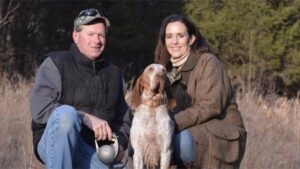
Kristi Libertore is the breeder behind Whiskey Hills Bracchi Italiani. Read about the kennel’s beginnings, puppies, and much more!

Lonnie & Marsha’Carroll are the breeders behind Bear Hug Wirehaired Pointing Griffons. Read about the kennel’s beginnings, puppies, and more!
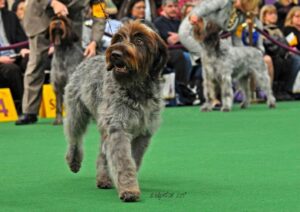
Discover the achievements of Wirehaired Pointing Griffons and the AWPGA. Learn about their excellence in hunting, showing, and more!
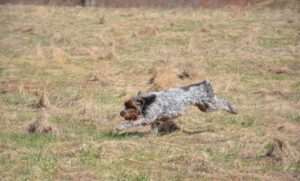
Form And Function Of The Wirehaired Pointing Griffon | American architect Louis Sullivan famously coined the phrase, “form follows function”
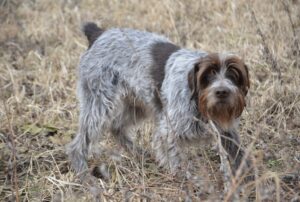
The American Wirehaired Pointing Griffon Association (AWPGA) adopted a working standard for the Wirehaired Pointing Griffon (Griffon) in

Dan Sayers is the Editor-in-Chief of SHOWSIGHT digital and print publications. He received a B.S. from Drexel University where he studied interior architectural design. His professional career has allowed him to develop his planning, problem-solving, and project management skills, which were employed in the office, educational, and financial sectors. While working as a project manager, he earned a Graphic Design Certificate from the University of the Arts and began creating ads for many of America’s top-winning show dogs. Through this work, Dan became Editor-in-Chief of the nation’s first online-only dog show publication. His current role expands on this experience and broadly extends to cover the sport of dogs in Companion and Performance events as well as all aspects of Conformation.
Dan is a long-time member of the Irish Water Spaniel Club of America and is the organization’s current AKC Delegate and Archivist/Historian, as well as a club-approved Breed Mentor. From 2000-2010, he was the club’s AKC Gazette Columnist. He breeds Irish Water Spaniels under the Quiet Storm prefix and has judged the IWSCA National Specialty Sweepstakes twice. Dan is a member of the Morris and Essex Kennel Club as well as the Dog Writers Association of America, which recognized his illustrations in the award-winning canine compendium, the Encyclopedia of K-9 Terminology.

"*" indicates required fields
Showsight Magazine–the world’s most influential purebred dog publication since 1992. Each issue reaches a global audience dedicated to preserving the history and health of purpose bred dogs. Filled with award-winning editorial focused on news and insights from the dog show community, top breeders, handlers, AKC Judges, and more!